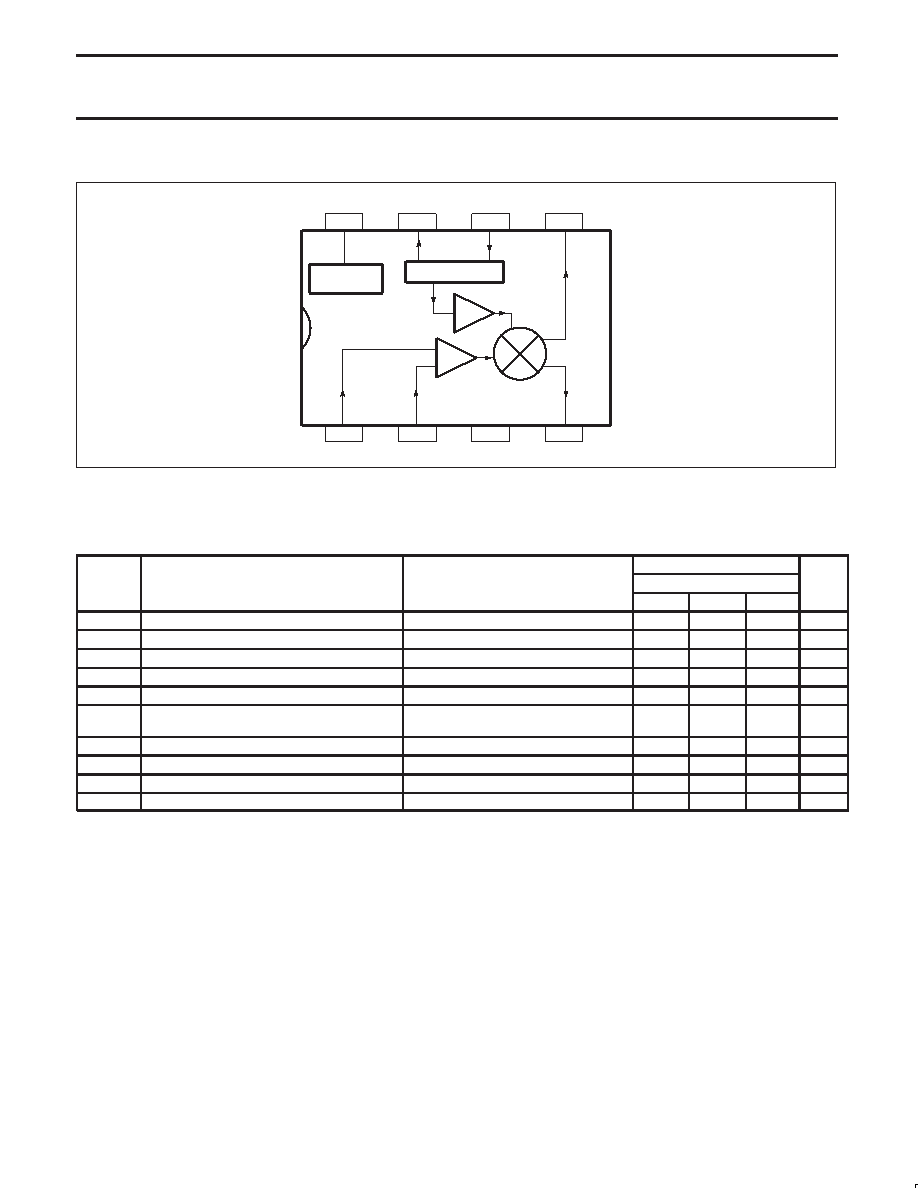- 您現(xiàn)在的位置:買賣IC網(wǎng) > PDF目錄24768 > 935030750602 (NXP SEMICONDUCTORS) SPECIALTY TELECOM CIRCUIT, PDSO8 PDF資料下載
參數(shù)資料
| 型號(hào): | 935030750602 |
| 廠商: | NXP SEMICONDUCTORS |
| 元件分類: | 通信及網(wǎng)絡(luò) |
| 英文描述: | SPECIALTY TELECOM CIRCUIT, PDSO8 |
| 封裝: | 3.90 MM, SOT-96-1, MS-012AA, PLASTIC, SO-8 |
| 文件頁(yè)數(shù): | 8/14頁(yè) |
| 文件大?。?/td> | 184K |
| 代理商: | 935030750602 |
第1頁(yè)第2頁(yè)第3頁(yè)第4頁(yè)第5頁(yè)第6頁(yè)第7頁(yè)當(dāng)前第8頁(yè)第9頁(yè)第10頁(yè)第11頁(yè)第12頁(yè)第13頁(yè)第14頁(yè)

Philips Semiconductors
Product specification
SA602A
Double-balanced mixer and oscillator
1997 Nov 07
3
BLOCK DIAGRAM
87
65
4
3
2
1
OSCILLATOR
VOLTAGE
REGULATOR
GROUND
V
CC
SR00069
Figure 2. Block Diagram
AC/DC ELECTRICAL CHARACTERISTICS
VCC = +6V, TA = 25°C; unless otherwise stated.
LIMITS
SYMBOL
PARAMETER
TEST CONDITIONS
SA602A
UNITS
MIN
TYP
MAX
VCC
Power supply voltage range
4.5
8.0
V
DC current drain
2.4
2.8
mA
fIN
Input signal frequency
500
MHz
fOSC
Oscillator frequency
200
MHz
Noise figure at 45MHz
5.0
5.5
dB
Third-order intercept point
RFIN = -45dBm: f1 = 45.0MHz
f2 = 45.06MHz
-13
-15
dBm
Conversion gain at 45MHz
14
17
dB
RIN
RF input resistance
1.5
k
CIN
RF input capacitance
3
3.5
pF
Mixer output resistance
(Pin 4 or 5)
1.5
k
DESCRIPTION OF OPERATION
The SA602A is a Gilbert cell, an oscillator/buffer, and a temperature
compensated bias network as shown in the equivalent circuit. The
Gilbert cell is a differential amplifier (Pins 1 and 2) which drives a
balanced switching cell. The differential input stage provides gain
and determines the noise figure and signal handling performance of
the system.
The SA602A is designed for optimum low power performance.
When used with the SA604 as a 45MHz cellular radio second IF and
demodulator, the SA602A is capable of receiving -119dBm signals
with a 12dB S/N ratio. Third-order intercept is typically -13dBm (that
is approximately +5dBm output intercept because of the RF gain).
The system designer must be cognizant of this large signal
limitation. When designing LANs or other closed systems where
transmission levels are high, and small-signal or signal-to-noise
issues are not critical, the input to the SA602A should be
appropriately scaled.
Besides excellent low power performance well into VHF, the
SA602A is designed to be flexible. The input, RF mixer output and
oscillator ports can support a variety of configurations provided the
designer understands certain constraints, which will be explained
here.
The RF inputs (Pins 1 and 2) are biased internally. They are
symmetrical. The equivalent AC input impedance is approximately
1.5k || 3pF through 50MHz. Pins 1 and 2 can be used
interchangeably, but they should not be DC biased externally.
Figure 5 shows three typical input configurations.
The mixer outputs (Pins 4 and 5) are also internally biased. Each
output is connected to the internal positive supply by a 1.5k
resistor. This permits direct output termination yet allows for
balanced output as well. Figure 6 shows three single ended output
configurations and a balanced output.
相關(guān)PDF資料 |
PDF描述 |
|---|---|
| 935030750623 | SPECIALTY TELECOM CIRCUIT, PDSO8 |
| 935030770602 | SPECIALTY TELECOM CIRCUIT, PDIP8 |
| 0643231219 | 2 mm2, COPPER ALLOY, TIN FINISH, WIRE TERMINAL |
| 935031370602 | F/FAST SERIES, OCTAL 1-BIT REGISTERED TRANSCEIVER, TRUE OUTPUT, PDIP24 |
| 935031360623 | F/FAST SERIES, OCTAL 1-BIT REGISTERED TRANSCEIVER, TRUE OUTPUT, PDSO24 |
相關(guān)代理商/技術(shù)參數(shù) |
參數(shù)描述 |
|---|---|
| 935030750623 | 制造商:NXP Semiconductors 功能描述:IC MIXER 500MHZ UP CONVRT 8SO |
| 9350317 | 制造商:Honeywell / Clarostat 功能描述:SST PRESSURE TRANSDUCERS 制造商:Honeywell Sensing and Control 功能描述:SST PRESSURE TRANSDUCERS 制造商:Honeywell Sensing and Control 功能描述:9350317 SST PRESSURE TRANSDUCERS |
| 935032 | 制造商:JWMILLER 功能描述: |
| 9350-3R1 | 制造商:Johanson Manufacturing 功能描述:VARIABLE CAPACITOR |
| 935040870112 | 制造商:NXP Semiconductors 功能描述:IC MIXER FM IF SYSTEM LP 20-SSOP |
發(fā)布緊急采購(gòu),3分鐘左右您將得到回復(fù)。